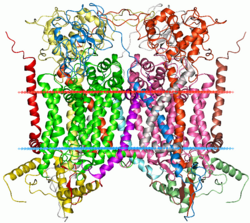Cytochrome b
| Cytochrome b, C-terminal domain | |||||||||
|---|---|---|---|---|---|---|---|---|---|
 Mitochondrialcytochrome bc1 complex | |||||||||
| Identifiers | |||||||||
| Symbol | Cytochrom_B_C | ||||||||
| Pfam | PF00032 | ||||||||
| InterPro | IPR005798 | ||||||||
| |||||||||
Cytochrome bis a protein found in the membranes of aerobic cells. Ineukaryoticmitochondria(inner membrane) and in aerobicprokaryotes,cytochrome b is a component ofrespiratory chaincomplex III(EC1.10.2.2) — also known as the bc1 complex or ubiquinol-cytochrome c reductase. In plantchloroplastsandcyanobacteria,there is a homologous protein, cytochrome b6, a component of theplastoquinone-plastocyanin reductase(EC1.10.99.1), also known as the b6f complex. These complexes are involved inelectron transport,the pumping of protons to create a proton-motive force (PMF). Thisproton gradientis used for the generation ofATP.These complexes play a vital role in cells.[1][2][3]
Structure and function
[edit]Cytochrome b/b6 is an integralmembrane proteinof approximately 400amino acid residuesthat probably has 8transmembrane segments.In plants and cyanobacteria, cytochrome b6 consists of twoprotein subunitsencoded by the petB and petD genes. Cytochrome b/b6 non-covalently binds twohemegroups, known as b562 and b566. Four conserved histidine residues are postulated to be theligandsof the iron atoms of these two heme groups.[2][3]
The heme groups are key parts of the internal electron transfer pathway and indispensable to the functioning of the two quinol oxidizing complexes. Two units of b/b6 also form a quinol entry pathway.[4]
Use in phylogenetics
[edit]Cytochrome b is commonly used as a region ofmitochondrial DNAfor determiningphylogeneticrelationships between organisms, due to its sequence variability. It is considered to be most useful in determining relationships withinfamiliesandgenera.Comparative studies involving cytochrome b have resulted in new classification schemes and have been used to assign newly described species to a genus as well as to deepen the understanding of evolutionary relationships.[5]
Clinical significance
[edit]Mutations in cytochrome b primarily result inexercise intolerancein human patients; though more rare, severe multi-system pathologies have also been reported.[6]
Single-point mutations in cytochrome b ofPlasmodium falciparumandP. bergheiare associated with resistance to the anti-malarial drugatovaquone.[7]
Human genes
[edit]Human genes encoding cytochrome b proteins include:
- CYB5A– cytochrome b5 type A (microsomal)
- CYB5B– cytochrome b5 type B (outer mitochondrial membrane)
- CYBASC3– cytochrome b, ascorbate dependent 3
- MT-CYB– mitochondrially encoded cytochrome b
Fungicide target
[edit]Cyt b is targeted by theQoIclass of fungicides,Fungicide Resistance Action Committeegroup 11. The cyt b mutationsG143AandF129Lprovide resistance against the main body of group 11, although G143A does not work againstmetyltetraprole(11A).[8]G143A is significantinBotrytis cinereain California strawberry production.[9]
References
[edit]- ^Blankenship, Robert (2009).Molecular Mechanisms of Photosynthesis.Blackwell Publishing. pp. 124–132.
- ^abHowell N (August 1989). "Evolutionary conservation of protein regions in the proton motive cytochrome b and their possible roles in redox catalysis".J. Mol. Evol.29(2): 157–69.Bibcode:1989JMolE..29..157H.doi:10.1007/BF02100114.PMID2509716.S2CID7298013.
- ^abEsposti MD, De Vries S, Crimi M, Ghelli A, Patarnello T, Meyer A (July 1993)."Mitochondrial cytochrome b: evolution and structure of the protein"(PDF).Biochim. Biophys. Acta.1143(3): 243–71.doi:10.1016/0005-2728(93)90197-N.PMID8329437.
- ^Sarewicz, M; Pintscher, S; Pietras, R; Borek, A; Bujnowicz, Ł; Hanke, G; Cramer, WA; Finazzi, G; Osyczka, A (24 February 2021)."Catalytic Reactions and Energy Conservation in the Cytochrome bc(1) and b(6)f Complexes of Energy-Transducing Membranes".Chemical Reviews.121(4): 2020–2108.doi:10.1021/acs.chemrev.0c00712.PMC7908018.PMID33464892.
- ^Castresana, J. (2001)."CytochromebPhylogeny and the Taxonomy of Great Apes and Mammals ".Molecular Biology and Evolution.18(4): 465–471.doi:10.1093/oxfordjournals.molbev.a003825.PMID11264397.
- ^Blakely EL, Mitchell AL, Fisher N, Meunier B, Nijtmans LG, Schaefer AM, Jackson MJ, Turnbull DM, Taylor RW (July 2005)."A mitochondrial cytochrome b mutation causing severe respiratory chain enzyme deficiency in humans and yeast".FEBS J.272(14): 3583–92.doi:10.1111/j.1742-4658.2005.04779.x.PMID16008558.S2CID13938075.
- ^Siregar JE, Syafruddin D, Matsuoka H, Kita K, Marzuki S (June 2008). "Mutation underlying resistance ofPlasmodium bergheito atovaquone in the quinone binding domain 2 (Qo(2)) of the cytochrome b gene ".Parasitology International.57(2): 229–32.doi:10.1016/j.parint.2007.12.002.PMID18248769.
- ^FRAC (Fungicide Resistance Action Committee) (March 2021)."FRAC Code List ©*2021: Fungal control agents sorted by cross resistance pattern and mode of action (including coding for FRAC Groups on product labels)"(PDF).Archived fromthe original(PDF)on 2021-11-05.Retrieved2021-06-16.
- ^
- Petrasch, Stefan; Knapp, Steven J.; van Kan, Jan A. L.; Blanco-Ulate, Barbara (2019-04-04)."Grey mould of strawberry, a devastating disease caused by the ubiquitous necrotrophic fungal pathogenBotrytis cinerea".Molecular Plant Pathology.20(6).British Society for Plant Pathology(W-B): 877–892.doi:10.1111/mpp.12794.ISSN1464-6722.PMC6637890.PMID30945788.S2CID93002697.
- Cosseboom, Scott D.; Ivors, Kelly L.; Schnabel, Guido; Bryson, Patricia K.; Holmes, Gerald J. (2019)."Within-Season Shift in Fungicide Resistance Profiles ofBotrytis cinereain California Strawberry Fields ".Plant Disease.103(1).American Phytopathological Society:59–64.doi:10.1094/pdis-03-18-0406-re.ISSN0191-2917.PMID30422743.S2CID205345358.
External links
[edit]- Cytochromes+bat the U.S. National Library of MedicineMedical Subject Headings(MeSH)
